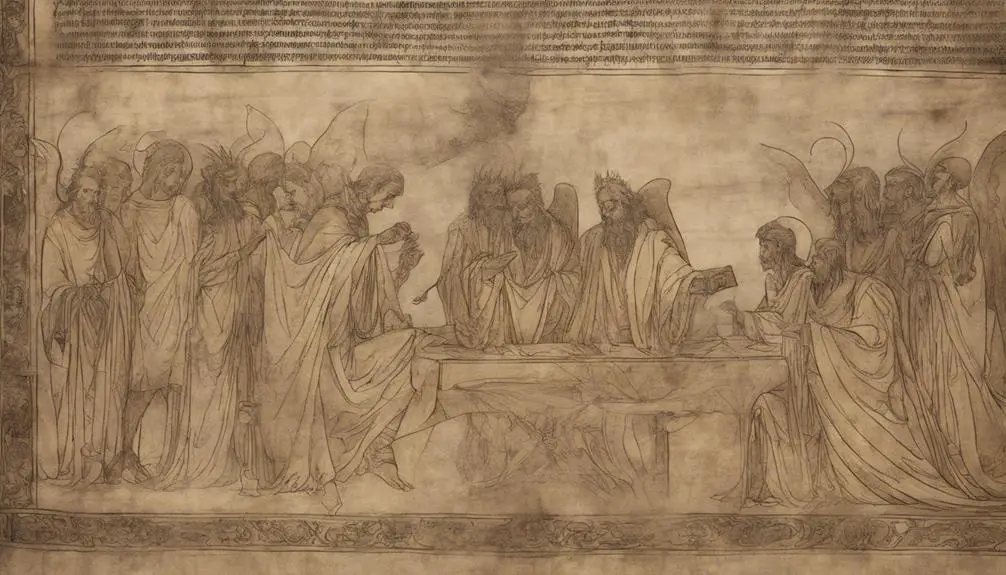Often overlooked, the Bible's vulgarity reveals deeper insights into its teachings, urging a closer examination of its contentious passages.

Vulgarity in the Bible
Navigating through the Bible can sometimes feel like walking through a minefield of vulgarity, from sexual imagery to profane language and even scenes of violence. You might find yourself questioning how these elements fit within a sacred text.
This journey into the Bible's more controversial content is not just about uncovering what's hidden beneath the surface, but also understanding the context and the message these passages intend to convey.
Let's explore these aspects further, and you might discover that what at first appears vulgar holds deeper meanings that are crucial to the Bible's overarching narrative.
Key Takeaways
- The Bible employs sexual metaphors and imagery to convey spiritual concepts and relationships.
- Cultural and historical contexts are essential for understanding the instances of what might be perceived as vulgarity.
- Profane language and curses in the Bible reflect the societal norms and linguistic practices of the time.
- Allegorical interpretations of seemingly vulgar passages can reveal deeper, non-literal spiritual insights and teachings.
Sexual Imagery and Metaphors

Throughout the Bible, vivid sexual imagery and metaphors are occasionally utilized to convey complex spiritual and moral concepts. You'll find that these passages aren't gratuitous but serve to deepen the understanding of relationships—both human and divine—within the cultural context of the times.
The Song of Solomon is perhaps the most well-known example, rich with erotic language that, on one level, celebrates the love between a man and a woman. However, allegorical interpretations suggest it also symbolizes the love between God and His people. This dual understanding highlights the Bible's layered meanings and the importance of context.
In Ezekiel and Hosea, sexual metaphors are employed to illustrate Israel's infidelity to God, likening the nation to a promiscuous wife. These metaphors aren't meant to shock but to evoke a strong emotional response from the reader, urging a reflection on spiritual faithfulness and moral integrity.
Understanding these passages requires recognizing the cultural context in which they were written. The Bible uses the language and imagery familiar to its original audience to communicate messages that were spiritually significant. By appreciating the allegorical interpretations, you gain insight into the profound ways the Bible addresses human relationships and divine love.
Profane Language and Curses
Moving beyond the realm of sexual imagery, the Bible also incorporates instances of profane language and curses to convey its messages. This aspect of biblical language, while surprising to some, plays a critical role in the narratives and teachings within these sacred texts. The use of such language, when analyzed through the lenses of linguistic evolution and cultural context, reveals much about the societies from which these texts emerged.
Understanding the presence of profane language and curses involves considering:
- The historical context in which these words were used, highlighting the social norms and values of the time.
- Linguistic evolution, acknowledging how meanings and connotations of words change over time.
- Cultural relativity, recognizing that what's considered profane or cursing varies across cultures.
- The intention behind the language, whether to shock, instruct, or express deep emotion.
- The impact on contemporary readers, how modern interpretations of these words can differ significantly from their original meanings.
Scenes of Violence and Bloodshed

In exploring the Bible's narrative landscape, one can't overlook the vivid depictions of violence and bloodshed that serve to underscore the gravity of human actions and divine interventions. These scenes, often stark and unsettling, aren't gratuitous. Instead, they're integral to conveying themes of divine justice within the historical context of the times.
You'll find that the Bible doesn't shy away from detailing battles, sacrifices, and punishments. Such accounts aren't merely historical records but are imbued with lessons on morality, justice, and the consequences of straying from divine laws. The portrayal of violence serves as a stark reminder of the serious repercussions of sin, both on a personal and communal level.
Moreover, understanding these narratives within their historical context is crucial. The societal norms and conditions of ancient times were vastly different from today's. Acts of violence, while difficult for modern readers to comprehend, were part of the fabric of ancient societies.
In this light, the Bible's graphic scenes of violence and bloodshed aren't merely tales of gore and brutality. They're complex, layered stories that contribute to the overarching message of divine justice and the relentless pursuit of righteousness and peace.
Descriptions of Bodily Functions
You'll discover that the Bible doesn't shy away from depicting bodily functions, presenting these elements in a manner that reflects the human experience in its rawest form. This candid representation serves not only to connect with the audience on a fundamental level but also plays a crucial role in the broader themes of ritual purity and dietary laws. These narratives and laws aren't merely historical or cultural artifacts; they embody deep theological and ethical teachings.
The Bible's approach to bodily functions can be seen as a testament to its authenticity and relevance, demonstrating a profound understanding of human nature:
- It acknowledges the natural processes that are common to all humans, regardless of status or sanctity.
- The text often ties these functions to laws about cleanliness and health, showing a concern for both spiritual and physical well-being.
- Dietary laws, in particular, reflect a deep connection between what's consumed and one's spiritual state.
- Ritual purity practices highlight a societal framework aimed at maintaining both communal and individual holiness.
- These descriptions and laws encourage readers to reflect on their bodies as temples, deserving of care and respect.
This perspective invites a more nuanced understanding of the Bible, where the sacred and the corporeal intersect, offering insights into the complexities of the human condition.
Controversial Moral Teachings

The Bible's moral teachings, while foundational to many ethical systems, have sparked significant debate and controversy over the centuries. You've likely encountered or pondered the complexities surrounding topics like slavery endorsement and gender roles within its texts.
Topic |
Controversy |
Reflection |
|---|---|---|
Slavery |
The Bible contains passages that seem to endorse slavery. |
Modern interpretations often grapple with this, seeking contexts and counterpoints within the scripture itself. |
Gender Roles |
Prescriptive roles for men and women can appear rigid and outdated. |
Scholars and theologians debate their relevance today, considering cultural and historical contexts. |
Divine Justice |
Harsh punishments and divine retribution can challenge contemporary morality. |
Interpretations vary, with some viewing these as metaphorical or specific to their time. |
Love and Forgiveness |
Calls for love and forgiveness are sometimes seen in tension with other teachings. |
This duality prompts discussions on the overarching message of the Bible and its application in modern life. |
Analyzing these aspects, it's essential to approach the Bible with a nuanced understanding, recognizing the historical and cultural contexts in which it was written. This doesn't diminish its value but invites a deeper exploration of its teachings and their implications for today's moral and ethical discussions.
Frequently Asked Questions
How Have Different Translations of the Bible Addressed and Potentially Altered the Perceived Vulgarity in the Original Texts?
Different translations of the Bible have tackled the challenge of original texts' nuances through varied translation methodologies.
You'll find that linguistic evolution plays a crucial role in how translators choose to convey or soften certain expressions.
They meticulously analyze the context, ensuring their interpretations remain faithful yet sensitive to modern readers' sensibilities.
This approach allows for a scholarly, respectful bridge between historical accuracy and contemporary understanding.
What Role Does Cultural Context Play in Understanding What Is Considered Vulgar or Offensive in the Bible?
Cultural context shapes our understanding of language, including what's seen as coarse or refined. Linguistic evolution and historical puritanism play key roles in this perception.
As words age, their impact shifts, influenced by societal norms and values. This process affects how you interpret texts from different eras.
To fully grasp the nuances of any work, including ancient writings, you must consider the cultural lens through which it was created and is now viewed.
How Have Perceptions of Vulgarity in the Bible Changed Over Time Among Scholars and Religious Communities?
Your understanding of how perceptions have evolved over time among scholars and religious communities hinges on recognizing shifts in modern censorship and historical interpretation.
Initially, what was once deemed vulgar or offensive is now often seen through a lens of cultural and historical context. This evolution reflects a deeper, more nuanced appreciation of texts, moving beyond surface interpretations to consider the intent and circumstances of the time, thereby reshaping our grasp of ancient narratives.
In What Ways Have Discussions About Vulgarity in the Bible Impacted Interfaith Dialogues and Relationships Between Different Religious Groups?
Imagine you're part of a discussion group with diverse religious backgrounds. The way you tackle sensitive topics, like vulgarity, can either bridge gaps or widen them.
When it comes to interfaith dialogues, addressing content that might be seen as vulgar with respect and understanding is crucial. It's a delicate balance between vulgarity normalization and interfaith etiquette.
This approach has slowly transformed discussions, fostering deeper respect and understanding among different religious groups.
How Does the Presence of Vulgarity in the Bible Influence Its Use in Educational Settings, Such as Schools or Religious Instruction Classes?
When integrating the Bible into educational settings, curriculum design must carefully navigate its content. You'll find that the presence of controversial elements requires thoughtful consideration to ensure it's appropriate for all ages.
This often involves incorporating parental guidance to address sensitive topics. The goal is to foster an environment that respects diverse viewpoints while providing a comprehensive understanding of the material, ensuring it enriches rather than offends.
Conclusion
In the tapestry of the Bible, threads of vulgarity weave through, not to fray its sanctity but to enrich its human cloth. These elements, from sexual metaphors to scenes of violence, serve not as blemishes but as stark, symbolic hues highlighting humanity's complex nature.
They remind you that sacred texts mirror real life, in its rawness and beauty. Thus, understanding these passages demands a nuanced lens, appreciating their role in illustrating profound, often uncomfortable truths about human existence and divine interaction.



Sign up